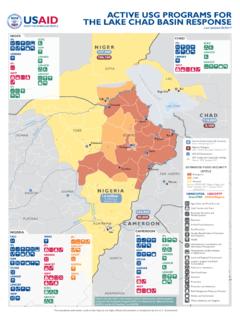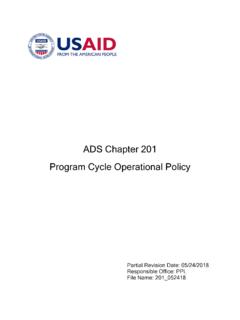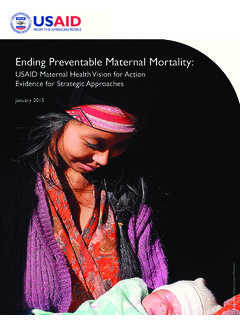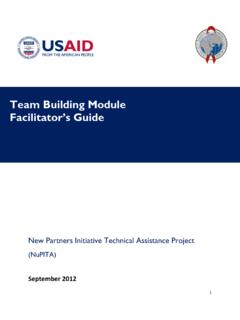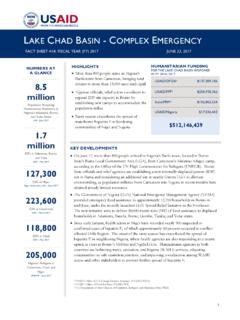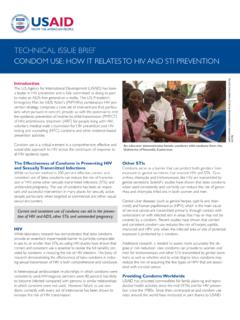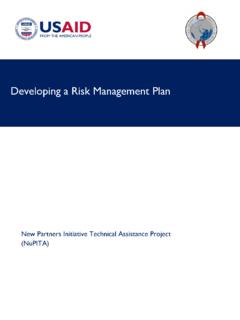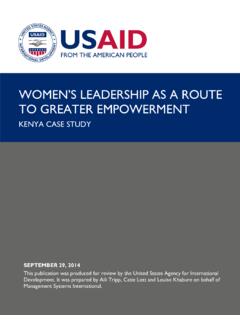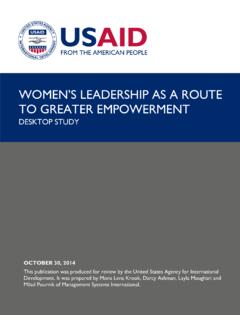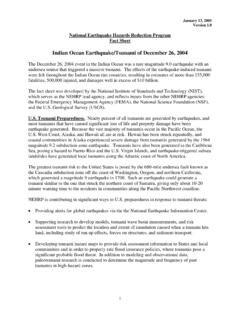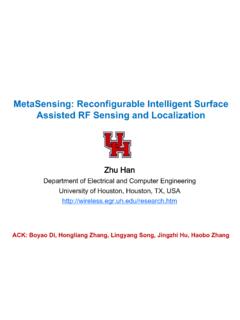Transcription of DIGITAL FARMER PROFILES - United States Agency for ...
1 DIGITAL FARMER PROFILES : Reimagining Smallholder AgricultureACKNOWLEDGEMENTSD igital Development for Feed the Future is a collaboration between the Global Development Lab and the Bureau for Food Security, both within the United States Agency for International Development (USAID), and is focused on integrating a suite of coordinated DIGITAL tools and technologies into Feed the Future activities to accelerate agriculture-led economic growth and improved nutrition. Feed the Future is America s initiative to combat global hunger and thanks go to all the service providers and others (listed in Annex 1) who gave of their time to contribute to this landscape assessment through interviews and email exchanges and for directing our team to additional resources. We hope we have adequately presented their work, experiences, and opinions. The authors of this publication would like to express their gratitude to the many Grameen Foundation team members who assisted in conducting interviews and identifying resources for this research: Maria Hernandez, Gaurav Chakraverty, Simon Okot, Evelyne Banura, Brigitta Nyawira, and Benjamin Kimosop.
2 Also, of the Grameen Foundation, we would like to express our gratitude to Lauren Hendricks, Sybil Chidiac, Jessie Tientcheu, Gigi Gatti, and Emily Romero for their thought leadership and support, and to Brent Farrar, Bee Wuethrich, and Liselle Yorke for their graphic design and communications assistance. Additional thanks go to Bee Wuethrich of Grameen Foundation for her , we would like to voice our appreciation to Ellen Galdava and Abdul Bari Farahi from FHI 360 and Kwasi Donkor and Christopher Burns of USAID for their support, review, and input into this publication. November, 2018 AUTHORSB obbi Gray, Grameen FoundationLee Babcock, Grameen FoundationLeo Tobias, Grameen FoundationMona McCord, Grameen FoundationAna Herrera, Grameen FoundationCecil Osei, Grameen FoundationRamiro Cadavid, Grameen FoundationTABLE OF CONTENTSA bbreviations ..vGlossary ..viExecutive Summary ..1 I. Introduction ..3II. Defining Smallholder Farmers ..5 III. Service Provider Models Data Generators.
3 8IV. Types of Data Collected ..11V. Data Capture Methods ..19VI. Data Storage: Cloud Computing and Blockchain ..24 VII. Data Analytics ..27 VIII. Qualitative Analysis and Insights ..35IX. Data Sharing ..37X. Data Use ..41XI. What is Innovation in FARMER Profile Data Management? ..46 XII. Conclusion & Next Steps ..50 XIII. Case Studies on Innovative FARMER Profile Data Management ..53 Ricult Case Study ..55 Grameen Foundation Case Study ..62 CGIAR s Platform for Big Data in Agriculture ..68 Bibliography ..72 Annexes ..80 Annex 1: Key Informant Interviews ..80 Annex 2: Key questions for FARMER profile data asset management ..82 Photo by USAID NEATABBREVIATIONSAGRAA lliance for a Green Revolution in Africa APIA pplication Programming InterfaceARETA griculture Risk Evaluation ToolB2 BBusiness to BusinessB2 CBusiness to CustomerBIBusiness IntelligenceCBAC ommercial Bank of AfricaCGAPC onsultative Group to Assist the PoorCGIARC onsultative Group for International Agricultural ResearchCIATI nternational Center for Tropical Agriculture (part of CGIAR network)
4 CoPCommunity of PracticeCTAThe Technical Centre for Agricultural and Rural CooperationFAIRF indable, Accessible, Interoperable, ReusableFAOFood and Agriculture Organization FIFinancial InstitutionFUNDERF oundation for Rural Business DevelopmentGCAPG hana Commercial Agricultural Project GPSG lobal Positioning SystemGSMAG roupe Speciale Mobile AssociationHCDH uman-centered Designi2iImpact 2 InsightIARII ndian Agriculture Research Institute IVRI nteractive Voice ResponseKYCKnow Your CustomerLSTLand Surface Temperature LSMSL iving Standards Measurement StudyMNOM obile Network OperatorNDVIN ormalized Difference Vegetation Index NGONon-governmental OrganizationOBDO utbound DialingSMSS hort Message ServiceVGIV olunteered Geographic InformationWAAPPWest Africa Agricultural Productivity Program AlgorithmA set of rules to be followed in calculations or other problem-solving operations, especially by a Intelligence Emerged in the 1950s. The theory and development of computer systems to be able to perform tasks normally requiring human intelligence.
5 Big Data*Open, harmonized, interoperable, and integrated datasets from multiple domains aimed to accelerate agricultural research and data use in service of development secure distributed immutable database shared by all parties in a distributed network where transaction data can be IntelligenceUsing data generated by service users to make decisions about product/service AgricultureThoughtful use of data (often big data) to inform FARMER decisions and actions. It means having the right data, at the right time, to make better decisions that improve long-term profitability. Deep LearningEmerged in 2010s; a technique for implementing machine learning. FARMER EcosystemAn interconnected and coordinated network of support services, information, suppliers, buyers and actors that meet the needs of farming households. FARMER ProfileData collected on a FARMER and his or her farm that is used by a service provider or multiple service providers to design and direct products or services.
6 Internet of Things The interconnection via the internet of computing devices embedded in everyday objects, enabling them to send and receive data; , in soil, farm tools and Surface Temperature The temperature of the land itself rather than the ambient air above it (as is used in most typical temperature recording).Machine LearningAn algorithm that is trained, given input data, and then run on new data to predict the output. As the system processes more data, it learns from its mistakes. Emerged in 1980s. An approach for achieving artificial intelligence and is used in predictive, prescriptive, and cognitive analytics. Normalized Difference Vegetation Index A measure of plant health derived from satellite set of concepts and categories in a subject area or domain that shows their properties and the relations between them. Currently perceived as being necessary for interoperability of DialingAlso called voice SMS, is a pre-recorded message sent to mobile AgricultureAn integrated crop management system that attempts to match the kind and amount of inputs with the actual crop needs for small areas within a farm field.
7 Precision agriculture uses one or more of the following sources of data: soils, crops, nutrients, pests, moisture, or yield, for optimum profitability, sustainability, and protection of the environment. Also referred to as satellite Message ServiceKnown as SMS, written messages with limited character length sent to phones. GLOSSARYD efinitions are drawn from GSMA, i2i, CIAT/CGIAR, , University of Missouri, USDA, and others. *Big data has several different definitions that are outlined in this report. For this report, the CGIAR definition will be used. 1 EXECUTIVE SUMMARYEXECUTIVE SUMMARYMore than 500 million smallholder farms worldwide play a significant role in food production and the genetic diversity of the food supply. Until now, it has been difficult to get information to or from smallholder farmers, compounding basic infrastructural problems such as access to inputs, markets, financing, and training. The spread of mobile technology, remote - sensing data, and distributed computing and storage capabilities are opening new opportunities to integrate smallholder farmers into the broader agri-food system.
8 The scale of these changes holds out the potential for another agricultural revolution. As mobile technology use increases and improves in rural areas, the paradigm is also shifting for how smallholder farmers are profiled, how their needs are understood and met, how the impact of agricultural services is measured, how FARMER data is shared, and how a global body of knowledge can be built by drawing on typically siloed expertise and data. To help describe this shift in FARMER profile data management, Grameen Foundation conducted a landscape assessment that: Documents experiences in managing DIGITAL FARMER data by describing how smallholder farmers are defined, the types of service providers that collect FARMER profile data, how data is collected, analyzed, and used to support smallholders with products and services, and how this data is shared and managed. Highlights innovative models of smallholder FARMER data management and sharing to inspire new thinking among actors in this space.
9 Outlines key considerations when assessing existing or investing in new efforts to develop and leverage FARMER profile data. Over a three-month period, Grameen Foundation conducted a desk review of the existing literature, including peer-reviewed journal articles, project and program reports and presentations, blogs, and information provided on websites. Grameen Foundation also conducted approximately 50 key informant interviews with service providers,1 including mobile network operators (MNOs), agribusinesses, government, research firms, technical assistance providers, donors, and other actors. These service providers were assumed to provide a valid representation of current FARMER data management practice. Grameen Foundation also participated in the ICTforAG 2018 and Data Driven Agriculture: The Future of Smallholder FARMER Data Management and Use workshop in summer 2018, the latter organized by USAID funded and FHI 360 lead Mobile Solutions, Technical Assistance and Research (mSTAR) project, to gather additional input from technical specialists in the area.
10 This landscape assessment was meant to capture different contexts and stakeholders but not to be exhaustive. The insights collected are meant to guide development organizations, USAID, and other donors in using these models in their everyday operations or in project design. 1 A service provider can be any entity involved in data capture, packaging, and analysis to inform FARMER decision making inter alia an MNO, agribusiness, government, NGO, and research farms worldwide play a significant role in food production and the genetic diversity of the food THAN500 MILLION * 2 DATA-DRIVEN AGRICULTUREU nderstanding smallholder FARMER data management requires defining from whom data is captured and how it is captured, analyzed, used, and shared. The findings from the assessment revealed: Defining a smallholder FARMER is not easy; farmers are not homogeneous. The definition of a smallholder FARMER must be flexible to include particularly vulnerable people. Given there can be several farmers per plot of land, when aggregating data for either open data efforts or for sophisticated analytics, it is the farm itself that pulls data together.
